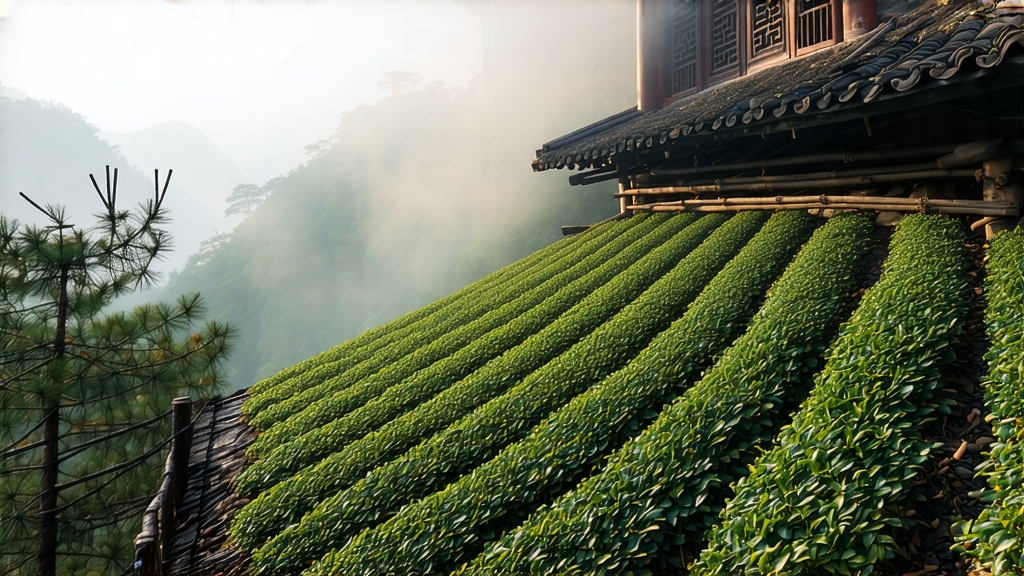
When European tea clippers first rounded the Cape of Good Hope in the early seventeenth century, the cargo that most excited London merchants was not silk or porcelain but a small-leaf black tea from the Wuyi massif of northern Fujian. They called it “Bohea,” a corruption of the local place-name Wuyi; the Chinese, however, knew the same leaf as zhengshan xiaozhong—“small-leaf from the original mountain.” Today the world knows it as Lapsang Souchong, the earliest style of black tea ever crafted and still the only one whose finishing note is the scent of burning pine.
History: from Ming border guards to Victorian breakfast cups
Legend places the birth of Lapsang Souchong in 1568, when a passing army bivouacked in the village of Tongmu during the late-Ming turmoil. To dry the freshly picked tea before the soldiers requisitioned every wicker rack, villagers hastily spread the leaves over pine fires. The smoke penetrated the leaf, creating an aromatic tea that fetched premium prices at the nearby Xingcun market. By 1604 Dutch traders had carried it to Amsterdam; by 1662 Catherine of Braganza’s dowry chest included Tongmu tea, cementing its place on English breakfast tables. The East India Company’s ledgers of 1678 list “Souchon” at twice the price of green tea, proof that smoke had already become luxury.
Geography: one canyon, two rivers, three microclimates
Authentic zhengshan xiaozhong can legally be produced only inside the 60 km² core zone of the Wuyi National Nature Reserve, an UNESCO dual heritage site where the Chong’an River and the Tongmu River carve misty gorges lined with junipers, camphor and Masson pines. Altitude ranges from 600 m to 1 400 m; diurnal temperature swings of 15 °C slow the leaf’s respiration, concentrating sugars and volatile oils. The soil is a weathered volcanic tuff so porous that walking on it sounds like treading shredded cork. Outside this micro-region, even identical cultivars and smoke give only “wai shan xiao zhong,” a tea that lacks the honeyed depth of the original mountain.
Cultivars: the pine-loving children of Wuyi
Most gardens are planted with a trio of indigenous bushes—Cai Cha (purple shoot), Que She (sparrow tongue) and the more recent hybrid Zhenghe Da Bai. Cai Cha yields the highest concentration of methyl salicylate, the compound that later marries with pine smoke to create Lapsang’s signature note of wintergreen and ripe longan. Farmers keep the bushes pruned to waist height so that mountain mist can linger around the bud; insect pressure is low at these cool elevations, making chemical pesticides unnecessary and allowing the tea to meet EU pesticide standards without washing.
Plucking: one bud, three leaves, before the valley warms
The harvest window opens in late April, when overnight lows still dip to 8 °C. Pickers climb wooden ladders lashed to granite outcrops, taking only the standard “one bud, three leaves” set that has unfurled within the previous 48 hours. A full basket weighs barely 500 g; 30 000 such sets produce 1 kg of finished tea. Leaves are carried down the gorge in wicker back-baskets lined with fresh banana leaf to prevent bruising, a technique unchanged since the Qing.
Withering: bamboo mats under starlight
Unlike flatland black teas that wither on mechanized troughs, Tongmu leaf is laid on sieves of split bamboo stacked inside “qing lou,” three-storey wooden houses whose top floor is open to the night sky. Here mountain wind and dew accomplish an 18-hour slow wither, reducing moisture from 78 % to 58 % while converting grassy aldehydes into floral alcohols. At dawn the leaf has lost its brittleness and exudes the scent of lychee skin.
Rolling: the moment when cell walls confess
Rolling is done on 150-year-old pine tables dusted with volcanic ash to prevent sticking. A master roller presses 3 kg of leaf at a time, using a wrist motion that spirals from the center outward—seven clockwise, seven counter-clockwise—until the leaf rope tightens and amber juice beads on the surface. The rupture rate must reach 85 %: enough to release polyphenol